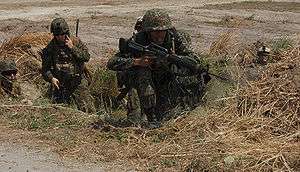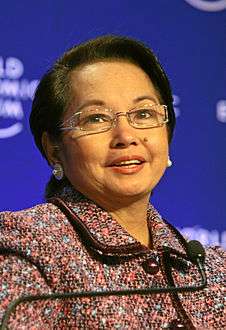Operation Enduring Freedom – Philippines
Operation Enduring Freedom – Philippines (OEF-P) or Operation Freedom Eagle was part of Operation Enduring Freedom and the global War on Terror.[11] The Operation targeted the various Jihadist terror groups operating in the country. By 2009, about 600 U.S. military personnel were advising and assisting the Armed Forces of the Philippines (AFP) in the Southern Philippines.[12] In addition, by 2014, the CIA had sent its elite paramilitary officers from their Special Activities Division to hunt down and kill or capture key terrorist leaders.[13] This group had the most success in combating and capturing Al-Qaeda leaders and the leaders of associated groups like Abu Sayyaf.[13]
| Operation Enduring Freedom – Philippines | |||||||
|---|---|---|---|---|---|---|---|
| Part of Philippine Civil Conflict, Global War on Terrorism | |||||||
 Philippine Marines training with American Marines | |||||||
| |||||||
| Belligerents | |||||||
|
|
| ||||||
| Commanders and leaders | |||||||
|
(2001-2010) (2010-2016) (2001-2009) (2009-2017) (2007-2009) (2002-2011) |
| ||||||
| Strength | |||||||
|
(Advisors/Trainers) |
| ||||||
| Casualties and losses | |||||||
|
| |||||||
| Causes: Communist Rebellion, Moro Rebellion and 9/11 Attacks | |||||||
Background
The 1898 Treaty of Paris ended the Spanish–American War, with Spain ceding the Philippines to the United States. Islam had arrived in the Philippines before the Spanish. Spain had conquered the northern islands, and the southern islands had become the Sultanate of Sulu (which was a Spanish protectorate, but not under direct administration).[14] The Spanish cession included the islands of Mindanao and the Sulu Archipelago, and the ceded territory included the islands of the Sultanate of Sulu located in the Philippine archipelago where slavery and piracy had for centuries been practiced by the Moros. The Spanish had established coastal garrisons but had never controlled the jungle interiors of the islands.[15]
In 1899, U.S. Brigadier General John C. Bates negotiated the Kiram-Bates Treaty for American Sovereignty over the Moro land, which recognized and respected the position of the Sultan and the Sultanate as well as their Muslim traditions, laws, and practices with the Sultan of Sulu.[16] After the U.S. had completed its goal of suppressing the resistance in Luzon in the Spanish–American War, it unilaterally abrogated the Bates Treaty on March 2, 1904, claiming the Sultan had failed to quell Moro resistance and that the treaty was a hindrance to the effective colonial administration of the area. Bates later confessed that the agreement was merely a temporary expedient to buy time until the northern forces were defeated.[17][18][19]
Forces
Special Operations Command, Pacific (SOCPAC) troops were the core of Operation Enduring Freedom – Philippines (OEF-P), an operation which supports the Government of the Republic of the Philippines counterterrorism efforts. The AFP and civilian authorities had improved their ability to coordinate and sustain counterterrorism operations. U.S. and Philippine forces had also worked together under the new Security Engagement Board framework – the primary mechanism for consultation and planning regarding non-traditional security threats – to complete humanitarian and civil assistance projects and improve living conditions in the southern Philippines. As a result of their combined efforts, support for terrorists had waned markedly.
Deployment first began January 2002 and involved more than 1,200 members of SOCPAC, headed by Brig. General Donald C. Wurster. SOCPAC's deployable joint task force HQ, Joint Task Force 510 (JTF 510), directed and carried out the operation.[20]
The mission was to advise the Armed Forces of the Philippines in combating terrorism in the Philippines.[21] 160 U.S. special forces go out on patrol with Filipinos in jungles of Basilan island, an Abu Sayyaf stronghold, in 2002, U.S. military personnel deployed to Cebu to provide support for a six-month exercise.[22] JSOC could undertake psychological operations to confuse or trap al-Qaeda operatives, but it needed approval from the White House for lethal action.[23] Much of the mission (Exercise Balikatan 02-1) took place on the Basilan Island.
Mission
The mission of the Joint Special Operations Task Force in the Philippines (JSOTF-P) was
[T]o support the comprehensive approach of the Armed Forces of the Philippines (AFP) in their fight against terrorism in the southern Philippines. At the request of the Government of the Philippines, JSOTF-P works alongside the AFP to defeat terrorists and create the conditions necessary for peace, stability and prosperity.[24]
Combatants
Armed Forces of the Philippines
United States Armed Forces
The United States had provided the Philippine government with advisors, equipment and financial support to counter Abu Sayyaf and Jemaah Islamiyah.[25] In order to provide a legal basis for the presence of U.S. forces despite provisions in the 1987 Philippine constitution specifically banning the presence of foreign troops, Philippine president Gloria Arroyo invoked the 1951 Mutual Defense Treaty between the U.S. and the Philippines.[26] In 2013, operations began to wind down,[9] assisting Philippine forces against Muslim rebels in September 2013.[27] Joint Special Operations Task Force - Philippines disbanded in June 2014,[28] ending a successful 12-year mission.[29][30]
Timeline of American casualties
On 21 February 2002, the largest loss of life for U.S. forces occurred when 10 soldiers (8 from the E company, 160th SOAR and 2 from the 353rd Special Operations Group) were killed after their MH-47 crashed at sea in the Bohol Strait, southern Philippines, whilst scouting Islamic terrorists on Basilan Island.[22][31]
On 2 October 2002, a bombing at an open-air market outside the gate of Camp Enrile Malagutay in Zamboanga killed a U.S. Special Forces soldier from A Company, 2nd Battalion, 1st SFG.[32] One Filipino soldier and one civilian were also killed, and 21 people were wounded including one U.S. and two Filipino soldiers.[31][33][34]
On 30 June 2004, a U.S. Special Forces soldier from 2nd Battalion, 1st SFG, was killed in a non-hostile incident in Manila.[31][35]
On 14 October 2005, a U.S. Special Forces soldier from 5th Battalion, 4th Psychological Operations Group, U.S. Army Special Operations Command. was killed in a non-hostile incident in Makati City.[31][36]
On 15 February 2007, a U.S. Marine from Combat Logistics Regiment 37, 3rd Marine Logistics Group was killed in a non-hostile incident in Jolo.[31][37]
On 27 October 2007, a U.S. Special Forces soldier from 2nd Battalion, 1st SFG was killed in an accidental drowning incident at Lake Seit in the southern Philippines.[31][38][39]
On 29 September 2009, a roadside bomb killed two U.S. Special Forces soldiers from 3rd battalion, 1st SFG[31][40] and a Philippine Marine on Jolo island.[41] Three other Philippine service members where injured in the blast. It was initially reported that the two U.S. casualties were Seabees.[12]
Abu Sayyaf
The Abu Sayyaf Group (ASG) is deemed a "foreign terrorist organization" by the United States government. Specifically, it is an Islamist separatist group based in and around the southern islands of the Republic of the Philippines, primarily Jolo, Basilan, and Mindanao.
Since inception in the early 1990s, the group has carried out bombings, assassinations, kidnappings, and extortion in their fight for an independent Islamic state in western Mindanao and the Sulu Archipelago, with a claimed overarching goal of creating a Pan-Islamic superstate across the Malay portions of Southeast Asia, spanning, from east to west, the large island of Mindanao, the Sulu Archipelago (Basilan and Jolo islands), the large island of Borneo (Malaysia and Indonesia), the South China Sea, and the Malay Peninsula (Peninsular Malaysia, Thailand and Burma).
The name of the group is Arabic for Father (Abu) of the Sword (Sayyaf).
Jemaah Islamiyah
Jemaah Islamiyah is a militant Islamic terrorist organization dedicated to the establishment of a fundamentalist Islamic theocracy in Southeast Asia, in particular Indonesia, Singapore, Brunei, Malaysia, the south of Thailand and the Philippines.
Jemaah Islamiyah is thought to have killed hundreds of civilians and is suspected of having executed the Bali car bombing on 12 October 2002 in which suicide bombers killed 202 people, mostly Australian tourists, and wounded many in a nightclub. After this attack, the U.S. State Department designated Jemaah Islamiyah as a Foreign Terrorist Organization. Jemaah Islamiyah is also suspected of carrying out the Zamboanga bombings, the Rizal Day Bombings, the 2004 Jakarta embassy bombing and the 2005 Bali terrorist bombing.
Financial links between Jemaah Islamiyah and other terrorist groups, such as Abu Sayyaf and al-Qaeda, have been found to exist.[42] Jemaah Islamiyah means "Islamic Group" and is often abbreviated JI.
Balikatan training exercises
The Balikatan training exercises were a part of OEF – Philippines which are mainly a series of joint training exercises between the Philippines and the United States. These training exercises are mainly taking place in Mindanao, the Spratly Islands, Tarlac, and other parts in the Philippines. The Balikatan training exercises are focused on joint training and counter-terrorist training aimed on strengthening relations between the Philippines, Morocco and the United States. The Balikatan training exercises are also aimed on training Filipino forces to fight the Abu Sayyaf and other Jihadist terror groups.
There have been allegations in the Philippine press and elsewhere that visiting forces from the United States appear to have become a permanent fixture in the landscape of Zamboanga City and other parts of Mindanao. Former presidential executive secretary of the Philippines Eduardo Ermita has responded to these allegations by saying, that the U.S. soldiers "... all look alike so it’s as if they never leave," going on to say that they "... are replaced every now and then. They leave, contrary to the critics’ impression that they have not left". These remarks were made in response to statements made by Edgar Araojo, a political science professor at Western Mindanao State University, that the country had surrendered its sovereignty. In specific response, Ermita said, "Our national sovereignty and territorial integrity are intact", going on to point out that the Balikatan exercises had bolstered national and regional security, and to say that terrorists and communist rebels were "common enemies of democracy, therefore there is nothing wrong with cooperation" between the armed forces of the US and the Philippines.[43]
Renewed mission
Following the Battle of Marawi in 2017, United States Secretary of Defense James Mattis declared a new counter terrorism mission to assist in the combat against affiliates of Islamic State of Iraq and the Levant. Australia also sent forces to assist the Armed Forces of the Philippines.[44] By August 2018, 250 Americans were involved in operations in the Philippines.[45]
References and notes
- "U.S. Officially Ends Special Operations Task Force in the Philippines, Some Advisors May Remain". 27 February 2015.
- "Appeal Restores Abu Bakar Bashir Sentence". The Australian. 29 February 2012.
- "FBI confirms 'most wanted' terror suspect Marwan killed after Philippines raid". CNN. 3 April 2015.
- Trevithick, Joseph (5 November 2014). "Yes, American Commandos Are Still in the Philippines". War is boring. Medium.com. Retrieved 2 January 2015.
- "More US troops deployed in Mindanao than Iraq, group claims". gmanetwork. 22 November 2014. Retrieved 22 November 2014.
- "2019 Philippines Military Strength". globalfirepower.com.
- Shankar, Sneha (26 June 2014). "US To Dissolve Anti-Terror Group, JSOTF-P, In Philippines After 10 Years Of Fighting Abu Sayyaf". International Business Times. Retrieved 3 December 2014.
- "Al-Qaeda map: Isis, Boko Haram and other affiliates' strongholds across Africa and Asia". 12 June 2014. Retrieved 22 November 2014.
- Mcleary, Paul (10 June 2013). "Is US Winding Down Spec Ops Mission in the Philippines?". Defense News. Gannett. Retrieved 3 December 2014.
- "Operation Enduring Freedom casualties". iCasualties. 30 August 2011. Retrieved 30 August 2011. (Note: apply filter for Country of Death = Philippines)
- Flashpoint, No bungle in the jungle, armedforcesjournal.com, retrieved 1 November 2007
Tyson Rininger (15 January 2009). F-15 Eagle at War. MBI Publishing Company. p. 73. ISBN 978-1-61673-269-1. - "2 US Navy men, 1 Marine killed in Sulu land mine blast". GMA News. 29 September 2009. Retrieved 29 September 2009.
Two US Navy personnel and one Philippine Marine soldier were killed when a land mine exploded along a road in Indanan, Sulu Tuesday morning, an official said. The American fatalities were members of the US Navy construction brigade, Armed Forces of the Philippines (AFP) spokesman Lt. Col. Romeo Brawner Jr. told GMANews.TV in a telephone interview. He did not disclose the identities of all three casualties.
and
Al Pessin (29 September 2009). "Pentagon Says Troops Killed in Philippines Hit by Roadside Bomb". Voice of America. Retrieved 12 January 2011. and
"Troops killed in Philippines blast". Al Jazeera. 29 September 2009. Retrieved 29 September 2009. and
Jim Gomez (29 September 2009). "2 US troops killed in Philippines blast". CBS News. Retrieved 12 January 2011. - "Al-Qaeda stalked by the Predator". Timesonline.co.uk. Retrieved 16 October 2014.
- Tucker, Spencer C. (2013). Encyclopedia of Insurgency and Counterinsurgency: A New Era of Modern Warfare. ABC-CLIO. p. 369. ISBN 978-1-61069-280-9.
- Tucker, Spencer C. (2009). Encyclopedia of the Spanish-American and Philippine-American Wars, The: A Political, Social, and Military History: A Political, Social, and Military History. ABC-CLIO. p. 415. ISBN 978-1-85109-952-8.CS1 maint: ref=harv (link)
- Robert A. Fulton. Moroland: The History of Uncle Sam and the Moros 1899-1920 (2009) pp 43-58
- Kho, Madge. "The Bates Treaty". Philippine Update. Retrieved 26 June 2015.
- Tarling, Nicholas (1999), The Cambridge History of Southeast Asia, Cambridge University Press, pp. https://books.google.com/books?id=e4kngeRds7kC&pg=PA59&dq=bates 59, ISBN 978-0-521-66371-7
- Tarling, Nicholas (2003), Imperialism in Southeast Asia, Routledge, p. 194, ISBN 978-1-134-57082-9
- "Lieutenant General Donald C. Wurster". Af.mil. Archived from the original on 24 July 2012. Retrieved 16 December 2010.
Cole, William (7 March 2015). "Hawaii-based troops close Philippine counterterror mission". Stars and Stripes. United States. Honolulu Star-Advertiser. Retrieved 9 March 2015. - Operation Enduring Freedom – Philippines, GlobalSecurity.org, retrieved 11 July 2007
- "'No survivors' in U.S. chopper crash". CNN. 24 February 2002. Retrieved 16 December 2010.
- "'Top Secret America': A look at the military's Joint Special Operations Command". the Washington post. 2 September 2011.
- "JSOTF-P web site". Jsotf-p.blogspot.com. Retrieved 16 December 2010.
- "Military Advisors in Philippines". Groups.sfahq.com. 11 January 2002. Archived from the original on 16 July 2011. Retrieved 16 December 2010.
- Michael Yew Meng Hor; Victor Vridar Ramraj; Kent Roach (2005). Global anti-terrorism law and policy. Cambridge University Press. pp. 313–314. ISBN 978-0-521-85125-1.
- Alipala, Julia S. (3 June 2014). "US military assisted PH forces during Battle of Zamboanga". Inquirer MIndanao. Retrieved 3 December 2014.
- "US ends Philippines anti-terror force". The Hindu. Associated Press. 26 June 2014. Retrieved 3 December 2014.
Gomez, Jim (26 June 2014). "US disbanding Philippines elite anti-terror force". The Philippine Star. Associated Press. Retrieved 3 December 2014. - Gordon Arthur; James Hardy (6 October 2014). "US, Philippines start 'PHIBLEX' drills as special forces mission draws down". IHS Janes 360. Retrieved 3 December 2014.
- Axe, David (13 May 2014). "FYI, We Just Won a War in the Philippines". War is boring. Medium.com. Retrieved 2 January 2015.
Munson, Mark (5 April 2013). "Has Operation Enduring Freedom-Philippines Been a Success?". Small Wars Journal. Small Wars Foundation. Retrieved 2 January 2015. - "Operation Enduring Freedom casualties". iCasualties. 21 July 2016. Retrieved 21 July 2016.
- "Sgt. 1st Class Mark Wayne Jackson". Projects.washingtonpost.com. 2 October 2002. Archived from the original on 14 April 2011. Retrieved 16 December 2010.
- "US, Filipino soldiers killed in bar bomb blast. 3/10/2002. ABC News Online". Australian Broadcasting Corporation. 3 October 2002. Retrieved 16 December 2010.
- "Philippine blast 'suicide attack'". CNN. 2 October 2002. Archived from the original on 4 June 2011. Retrieved 20 May 2010.
- "Defense.gov News Release: DoD Identifies Army Casualties No. 016-05 (January 06, 2005)". Defenselink.mil. 12 March 2009. Retrieved 16 December 2010.
- "Defense.gov News Release: DoD Identifies Army Casualty No. 1050-05 (October 15, 2005)". Defenselink.mil. 12 March 2009. Retrieved 16 December 2010.
- "Defense.gov News Release: DoD Identifies Marine Casualty No. 206-07 (February 22, 2007)". Defenselink.mil. 12 March 2009. Retrieved 16 December 2010.
- "The Mindanao Examiner: US Army Finally Names Dead Soldier In Southern Philippines". Zamboangajournalblogspot.com. Retrieved 16 October 2014.
- "DoD Identifies Army Casualties No. 763-09 (October 01, 2009)". Office of the Assistant Secretary of Defense (Public Affairs). 1 October 2009. Retrieved 3 October 2009.
- "2 U.S. soldiers killed in Philippines bomb blast". CNN. 2 October 2009. Retrieved 3 October 2009.
- Zachary Abuza (December 2003), Funding Terrorism in Southeast Asia: The Financial Network of Al Qaeda and Jemaah Islamiyah (PDF), 1, National Bureau of Asian Research, archived from the original (PDF) on 26 March 2009, retrieved 27 January 2008
- Michael Lim Ubac (7 September 2008), Palace: GIs all look alike, Philippine Daily Inquirer, archived from the original on 7 September 2008, retrieved 7 September 2008
- Fine, Glenn A.; Linick, Steve A.; Barr, Ann Calvaresi (31 December 2017). Overseas Contingency Operations: Operation Inherent Resolve Operation Pacific Eagle-Philippines (PDF) (Report). United States Department of Defense. Retrieved 18 February 2019.
- South, Todd (9 August 2018). "Pentagon to spend nearly $5M on Marine Corps mission in the Philippines". Marine Corps Times. Retrieved 18 February 2019.
Further reading
- Olivier Roy; Antoine Sfeir (2007). "Southeast Asian Islamism : Philippines". The Columbia World Dictionary of Islamism. Columbia University Press. pp. 332–333. ISBN 978-0-231-14640-1.
- Petit, Brian (February 2010). "Chapter 8. OEF Philippines: Thinking COIN, Practicing FID". United States Army Combined Arms Center. United States Army.
External links
- Operation Enduring Freedom – Philippines GlobalSecurity.org History of conflict
- Joint Special Operations Task Force Philippines News articles
- Balikatan
- Ressa, Maria A. (17 February 2015). "Context: The US in PH anti-terror campaigns". Rappler.
- Success in the Shadows: Operation Enduring Freedom–Philippines and the Global War on Terror, 2002–2015 https://www.armyupress.army.mil/Portals/7/combat-studies-institute/csi-books/success-in-the-shadows.pdf


